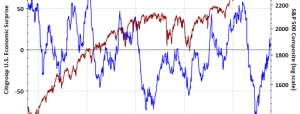BOE: Decision Preview
Image Source: The Bank of England policy decision is due later today and the overwhelming expectation is that the central bank will go ahead and cut rates by 25 basis points to 4.5%, the third rate cut since easing began last year.Video Length: 00:01:29
Brace For Impact: Nasdaq’s Big Moves Around Friday’s NFP
Instrument: Nasdaq Maximum Pattern Move: +7.35% Timeframe: Day of the NFP release Winning Percentage: 57.50% Seasonal Risk Event StrengthThe seasonal data for the Nasdaq 100 index () around Nonfarm Payrolls announcements indicates a weak historical trend, with an aggregate annualized return of -5.02%. While 57.50% of trades were winners, the losses outweighed gains, with an average return per trade of -0.04%. The largest single trade gains and losses were +7.35% and -6.83%, respectively, emphasizing a bearish bias during these events. Notably, returns tend to decline leading up to announcement days, followed by a recovery phase in the subsequent 3–5 days.This data suggests avoiding long trades before announcements due to the negative average returns and focusing on potential post-event rebounds. High volatility (25.18%) and significant downside risk highlight the importance of risk management with strict stop-loss levels. It is helpful to see that should we have a really large miss or beat in the NFP print there is potential for outsized moves in the Nasdaq, so momentum intraday traders can be prepared for quick, volatile moves.(Click on image to enlarge)Technical Perspective A technical look at the Nasdaq shows that the 100 and 200EMA sits below price on the daily chart (blue and red line below) and investors will be watching how much tariff concerns weigh on price heading into Friday’s NFP print.(Click on image to enlarge) Trade risksThe outlook for the Nasdaq over the NFP will be highly influences by the data released. There is therefore a significant data release risk to […]
Czech Inflation Slows Down, But Less Than Expected
Czech headline inflation slowed down to 2.8% annually, coming in above market expectations. We think the Czech National Bank is likely to proceed with a rate cut this afternoon, but the potent wage growth, accelerating prices in agriculture, and relatively elevated inflation print will definitely steer the discussion, contributing to a hawkish tone. Food prices strike backCzech annual inflation softened to 2.8% in January from 3.0% in December. The print came in above market expectations of 2.6%, mainly due to a more substantial increase in food prices. In contrast, price growth in the service sector slowed down in annual terms, suggesting a relatively stable rate of core inflation. Price growth has eased when food and energy are excluded as defined by the CZSO. Energy prices were the main drag on overall price growth, likely driven by lower electricity prices.In any case, this afternoon’s CNB meeting is expected to convey a hawkish message, especially since the proposed 25 basis point cut has become uncertain due to the relatively strong headline inflation figure. We saw the cut as a deal done if January’s inflation print came in below 2.7%. Nevertheless, the estimated 2.8% increase in consumer prices might be too potent, although driven by volatile food prices. We will likely see a split vote, with the base rate reduction pushed through by a tight majority.That said, the CNB forecasting and communication infrastructure is built pretty tightly around the CNB’s breakdown of CPI. There was never much hesitation about that in the building. The challenge lies […]
The Birth Death Adjustment: Trade With Caution
When formulating its monthly employment data, the BLS includes an adjustment for the net number of new jobs coming from new businesses and those lost by companies that have shut down. This adjustment is logical, as neither new nor closing firms are included in their surveys. While the so-called birth death adjustment is rational, the number of net jobs added due to the estimate can be incredibly flawed. The latest example is in the latest BLS .Within the summary covering March through June 2024, the BLS reports the following regarding its birth death adjustment: “The difference between the number of gross job gains and the number of gross job losses yields a net employment decline of 163,000 jobs in the private sector during the second quarter of 2024.” Interestingly, during that same period, the total birth death adjustment in the BLS reports added 683,000 jobs.The BLS presumes that the growing economy means the number of new businesses exceeds that of failing companies. Thus, the number of net jobs due to the birth and death of companies adds to the employment number. This has been wrong on numerous occasions. We bring this up because Friday’s employment data will have a big adjustment for the birth death rate. The markets will potentially be volatile if the number of jobs is well above or below forecasts. The birth death adjustment will be wrong and possibly by over 100,000 jobs. Such introduces the idiocy of the markets when it trades off one month of the […]
Forex Today: Gold, Coffee, Corn Hit New Highs Again
Image Source: With the US tariff issue temporarily defused, certain commodities continue to rise to significant highs, notably Gold, Coffee, and Corn. Gold is making market headlines today as it continued its strong bullish rise to new all-time high prices. However, in recent hours, it has sold off by a fair amount. Trend traders will be interested in being long of Gold now, and many analysts see a profit target at the next big round number of $3,000. Two other commodities remain in focus, having traded at or near new all-time highs yesterday: Coffee and Corn. Coffee is the stronger bullish trend, having risen by more than 10% in just a few days, and with a more long-term bullish technical picture. Corn traded at a new 1-year high yesterday, but some analysts think this rise will probably not have much further to run. Trend traders will probably be interested in positioning long here. Although Coffee futures can be expensive, retail traders and investors can gain exposure to Coffee via the COFF ETF, although US taxpayers should beware this is probably a PFIC for tax purposes. Recent comments by President Trump on Gaza, Iran, and the Iranian axis in general may be weighing on the price of Crude Oil which is traded near its 2025 low. China’s retaliatory tariffs on US imports will take effect next Monday, and this may also be weighing on the price of Crude Oil. The Japanese Yen rose strongly again yesterday, sending the USD/JPY currency pair to a fresh 6-week low, although the […]







